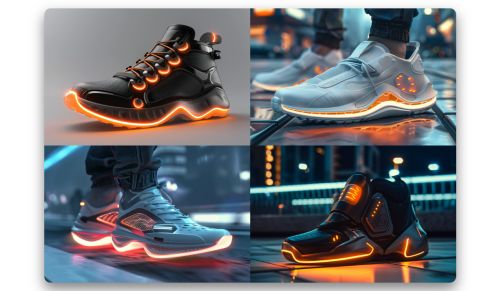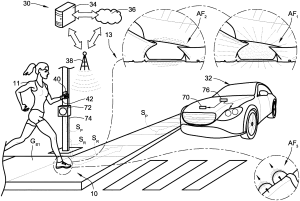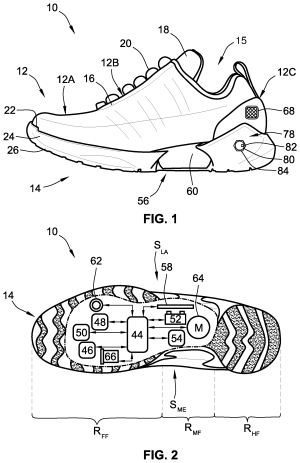US Patent Application 18447082. INTELLIGENT ELECTRONIC FOOTWEAR AND CONTROL LOGIC FOR AUTOMATED PEDESTRIAN COLLISION AVOIDANCE simplified abstract
Here's a rewrite of the MediaWiki page with detailed content for the requested sections:
Contents
- 1 INTELLIGENT ELECTRONIC FOOTWEAR AND CONTROL LOGIC FOR AUTOMATED PEDESTRIAN COLLISION AVOIDANCE
- 1.1 Artist's Impression
- 1.2 Organization Name
- 1.3 Inventor(s)
- 1.4 Simplified Explanation
- 1.5 Key Features and Innovation
- 1.6 Potential Applications
- 1.7 Problems Solved
- 1.8 Benefits
- 1.9 Commercial Applications: Smart Footwear Revolution in Pedestrian Safety
- 1.10 Prior Art
- 1.11 Frequently Updated Research
- 1.12 Patent Claims
INTELLIGENT ELECTRONIC FOOTWEAR AND CONTROL LOGIC FOR AUTOMATED PEDESTRIAN COLLISION AVOIDANCE
Artist's Impression
Organization Name
Inventor(s)
Christopher Andon of Portland OR (US)
Simplified Explanation
This patent application describes an innovative type of intelligent electronic footwear designed to enhance pedestrian safety. The shoes are equipped with advanced technology that can detect potential collisions with vehicles and warn the wearer. Here's how it works:
1. The shoes have a special detection tag that can receive signals from nearby transmitter-detector modules. 2. When the tag receives a signal, it sends a response back to the module. 3. This information is then processed by a remote computing system. 4. If the system detects a potential collision risk, it sends a warning signal to the shoes. 5. The shoes' built-in controller receives this signal and activates a warning system. 6. The warning system alerts the wearer through visual, audible, or tactile means.
This technology aims to significantly reduce pedestrian accidents by providing real-time warnings to people walking in potentially dangerous areas.
Key Features and Innovation
- Integration of electronic systems into footwear
- Detection tag for interaction with external transmitter-detector modules
- Wireless communication capabilities
- On-board footwear controller for processing signals
- Multi-modal warning system (visual, audible, tactile)
- Real-time threat detection and warning
- Automated collision avoidance system for pedestrians
Potential Applications
- Urban safety enhancement in high-traffic areas
- Improved safety for pedestrians in low-visibility conditions
- Enhanced protection for children and elderly pedestrians
- Integration with smart city infrastructure
- Use in industrial settings to prevent workplace accidents
- Application in sports and recreational activities for increased safety
- Potential integration with autonomous vehicle systems
Problems Solved
- Reduces pedestrian inattention to surrounding traffic
- Addresses the issue of pedestrians not being visible to drivers
- Mitigates risks associated with distracted walking
- Enhances safety in areas with high vehicle-pedestrian interaction
- Provides an additional layer of protection beyond traditional road safety measures
Benefits
- Increased pedestrian safety and reduced accident rates
- Real-time threat awareness for wearers
- Potential reduction in pedestrian fatalities and injuries
- Enhanced mobility and confidence for vulnerable pedestrians
- Seamless integration of safety technology into everyday footwear
- Potential reduction in healthcare costs associated with pedestrian accidents
- Improved urban livability through enhanced pedestrian safety
Commercial Applications: Smart Footwear Revolution in Pedestrian Safety
The intelligent electronic footwear described in this patent has significant commercial potential across various markets:
1. Consumer Market: Safety-conscious individuals, parents, and caregivers could drive demand for this technology in everyday footwear.
2. Urban Planning and Smart Cities: Municipalities might incorporate this technology into city-wide safety initiatives.
3. Industrial Safety: Companies could adopt this technology to enhance workplace safety in environments with heavy machinery or vehicle traffic.
4. Healthcare and Assisted Living: The footwear could be particularly valuable for patients with mobility issues or cognitive impairments.
5. Sports and Recreation: Integration into athletic footwear for enhanced safety during outdoor activities.
6. Insurance Industry: Potential for insurance companies to offer incentives for using such safety-enhancing technology.
7. Automotive Industry: Possible collaboration with car manufacturers for integrated vehicle-to-pedestrian communication systems.
Prior Art
While the abstract doesn't provide information on prior art, potential areas to explore for related technologies might include:
1. Wearable technology for pedestrian safety 2. Vehicle-to-pedestrian (V2P) communication systems 3. Smart city infrastructure for traffic management 4. Collision avoidance systems in autonomous vehicles 5. Augmented reality applications for pedestrian navigation 6. IoT devices for personal safety
Researchers interested in prior art could start by examining patents and academic papers in these fields, particularly those published before the filing date of this patent application.
Frequently Updated Research
For the most current research related to this technology, consider following these areas:
1. Smart wearable technology advancements 2. Developments in V2X (Vehicle-to-Everything) communication 3. Progress in pedestrian detection systems for autonomous vehicles 4. Innovations in urban safety infrastructure 5. Advancements in miniaturized sensors and low-power communication technologies 6. Research on human-computer interaction in safety applications 7. Studies on the effectiveness of wearable safety devices
Patent Claims
1. An Internet of Adaptive Apparel and Footwear (IoAAF) system for preventing a collision between a user and a machine moving in a building, the user having a portable electronic device with wireless communications capabilities, the IoAAF system comprising:
- an article of footwear or apparel configured to be worn by the user;
- a collision threat warning system mounted to the footwear or apparel and configured to generate visible, audible, and/or tactile outputs in response to command signals;
- a detection tag mounted to the footwear or apparel, the detection tag being configured to receive a prompt signal from a transmitter-detector module affixed to or located within the building and responsively transmit to the transmitter-detector module a response signal indicative of a location of the user;
- a wireless communications device mounted to the footwear or apparel, the wireless communications device configured to wirelessly connect to the portable electronic device and thereby wirelessly communicate with a remote computing node; and
- an electronic controller device connected to the wireless communications device and the collision threat warning system, the electronic controller device being configured to:
- receive, from the remote computing node via the wireless communications device, a collision warning signal generated responsive to the response signal indicating the location of the user is within a predetermined proximity or location to the moving machine; and
- transmit, in response to the received collision warning signal, a command signal to the collision threat warning system to generate a predetermined visible, audible, and/or tactile alert configured to warn the user of an impending collision with the moving machine.
2. The IoAAF system of claim 1, wherein the detection tag includes a radio frequency (RF) transponder, the prompt signal has a first RF power with a first frequency, and the response signal has a second RF power with a second frequency distinct from the first frequency.
3. The IoAAF system of claim 2, wherein the prompt signal received from the transmitter-detector module includes an embedded data set, and wherein the response signal retransmits the embedded data set back to the transmitter-detector module.
4. The IoAAF system of claim 3, wherein the RF transponder includes an RF antenna and a frequency filter connected to the RF antenna, the frequency filter being configured to reject signals having an RF power with a third frequency distinct from the first frequency.
5. The IoAAF system of claim 1, wherein the electronic controller device is further configured to:
- transmit, to the remote computing node via the wireless communications device, user dynamics data of the user; and
- receive, from the remote computing node via the wireless communications device, a collision threat value based on the user location and dynamics data and predictive of intrusion of the user with respect to the location and a predicted route of the moving machine.
6. The IoAAF system of claim 5, wherein the electronic controller device is further configured to transmit, to the remote computing node via the wireless communications device, behavioral data indicative of historical behavior of the user, wherein the collision threat value is further based on fusion of the behavioral data with the user location and dynamics data.
7. The IoAAF system of claim 6, wherein the collision threat value is further based on fusion of the behavioral data, user location, and user dynamics data with crowd-sourced data indicative of behavior of multiple users in proximity to the user.
8. The IoAAF system of claim 7, wherein the collision threat value is further based on fusion of the behavioral data, user location, user dynamics data, and crowd-sourced data with environmental data indicative of a surrounding environment of the user.
9. The IoAAF system of claim 1, wherein the wireless communications device includes a BLUETOOTH component or a near-field communications (NFC) component configured to wirelessly connect to the portable electronic device.
10. The IoAAF system of claim 1, wherein the collision threat warning system includes a haptic transducer attached to the footwear or apparel, and wherein the command signal causes the haptic transducer to generate a predetermined tactile alert configured to warn the user of the impending collision with the moving machine.
11. The IoAAF system of claim 1, wherein the collision threat warning system includes an audio component attached to the footwear or apparel, and wherein the command signal causes the audio component to generate a predetermined audible alert configured to warn the user of the impending collision with the moving machine.
12. The IoAAF system of claim 1, wherein the collision threat warning system includes a lighting element attached to the footwear or apparel, and wherein the command signal causes the lighting element to generate a predetermined visible alert configured to warn the user of the impending collision with the moving machine.
13. The IoAAF system of claim 1, further comprising a pressure sensor mounted to a sole structure of the footwear and configured to detect a presence of a foot of the user in an upper of the footwear, and wherein the command signal is transmitted to the collision threat warning system further in response to the detected presence of the foot in the upper.
14. The IoAAF system of claim 1, further comprising:
- a shoelace attached to an upper of the footwear; and
- a lace motor mounted inside a sole structure of the footwear and configured to selectively transition the shoelace between a tensioned state and an untensioned state,
wherein the electronic controller device is further configured to communicate with the lace motor and determine if the shoelace is in the tensioned state, and wherein the command signal is transmitted to the collision threat warning system further in response to the shoelace being in the tensioned state.
15. A method of operating an Internet of Adaptive Apparel and Footwear (IoAAF) system for preventing a collision between a user and a machine moving in a building, the user having a portable electronic device with wireless communications capabilities, the method comprising:
- receiving, via a detection tag attached to an article of footwear or apparel, a prompt signal from a transmitter-detector module affixed to or located within the building;
- transmitting, via the detection tag to the transmitter-detector module responsive to receiving the prompt signal, a response signal indicative of a location of the user;
- receiving, via an electronic controller device through a wireless communications device attached to the footwear or apparel, a collision warning signal generated by a remote computing node responsive to the response signal indicating the location of the user is within a predetermined proximity or location to the moving machine, wherein the wireless communications device wirelessly connects to the portable electronic device and thereby wirelessly communicates with the remote computing node; and
- transmitting, via the electronic controller device responsive to the received collision warning signal, a command signal to a collision threat warning system attached to the footwear or apparel to generate a predetermined visible, audible, and/or tactile alert configured to warn the user of an impending collision with the moving machine.
16. The method of claim 15, wherein the detection tag includes a radio frequency (RF) transponder, the prompt signal has a first RF power with a first frequency, and the response signal has a second RF power with a second frequency distinct from the first frequency.
17. The method of claim 15, further comprising:
- transmitting, via the electronic controller device to the remote computing node, user dynamics data of the user; and
- receiving, via the electronic controller device through the wireless communications device from the remote computing node, a collision threat value based on the user location and dynamics data and predictive of intrusion of the user with respect to the location and a predicted route of the moving machine.
18. The method of claim 15, further comprising detecting, via a pressure sensor mounted to the footwear, a presence of a foot in the footwear, and wherein the command signal is transmitted to the collision threat warning system further in response to the detected presence of the foot in the footwear.
19. The method of claim 15, wherein the moving machine is a robot, a motor vehicle, a forklift, and/or an automated guided vehicle (AGV), and wherein the building is a manufacturing facility and/or a storage facility.
20. An Internet of Adaptive Apparel and Footwear (IoAAF) system for preventing a collision between a user and a machine moving in a building, the IoAAF system comprising:
- an article of footwear or apparel configured to be worn by the user;
- a collision threat warning system mounted to the footwear or apparel and configured to generate visible, audible, and/or tactile outputs in response to command signals;
- a detection tag mounted to the footwear or apparel, the detection tag being configured to receive a prompt signal from a transmitter-detector module affixed to or located within the building and responsively transmit to the transmitter-detector module a response signal indicative of a location of the user;
- a wireless communications device mounted to the footwear or apparel and configured to wirelessly communicate with a remote computing node; and
- an electronic controller device connected to the wireless communications device and the collision threat warning system, the electronic controller device being configured to:
- transmit, to the remote computing node via the wireless communications device, user dynamics data and/or historical behavioral data of the user;
- receive, from the remote computing node, a collision warning signal generated responsive to the response signal indicating the location of the user is within a predetermined proximity or location to the moving machine;
- receive, from the remote computing node, a collision threat value based on fusion of the user location, user dynamics data, and/or historical behavioral data with crowd-sourced data indicative of behavior of users in proximity to the user, the collision threat value being predictive of intrusion of the user with respect to the location and a predicted route of the moving machine; and
- transmit, in response to the received collision warning signal, a command signal to the collision threat warning system to generate a predetermined visible, audible, and/or tactile alert configured to warn the user of an impending collision with the moving machine.



